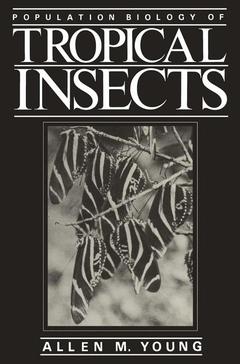Population Biology of Tropical Insects, Softcover reprint of the original 1st ed. 1982
Langue : Anglais
Auteur : Young Allen M.

In this book I have tried to bring together the major developments in the study of insect populations in tropical environments. In some ways, this task has been a difficult one because conceptually it is virtually impossible to limit a discussion of insect ecology to the tropics, since the same concepts, theories, and hypoth eses concerning the mechanisms by which habitats support insect populations often apply both to temperate and to tropical regions. Thus one might argue effectively that a book such as Peter Price's Insect Ecology represents a more comprehensive treatment of insect ecology, including the tropical aspects. Yet because there has been a tremendous amount of new study on insects in the tropics in recent years, and because there has also been a strong historical interest in tropical insects, judging from early museum expeditions and medically and agriculturally oriented studies of insects in the New and Old World tropics, I believe there is a place for a book dealing almost exclusively with tropical insects. But logically so, such a book by necessity incorporates data and informa tion from Temperate Zone studies, if for no other reason than because insights into the properties of tropical environments often emerge from compariso'ns of species, communities, or faunas between temperate and tropical regions. An understanding of insect populations in the tropics cannot be divorced from a consideration of Temperate Zone populations.
1. The Faunistic Richness of Insects in the Tropics: A Brief Overview.- 2. Individual and Population Responses to Environments.- 2.1. Ecological Response.- 2.2. Natural Selection.- 2.3. Some Properties of Populations.- 2.4. Ecological Diversity and the Tropics.- 2.5. Some Mechanisms Underlying Tropical Insect Density.- 2.6. Strategies of Response to the Environment.- 2.7. Natural Selection and Properties of Populations.- 2.8. Environmental Predictability and Response Patterns.- 3. Machinery of Environmental Response Mechanisms in Insects: Key to Evolutionary and Ecological Diversification.- 3.1. Notes on Insect Diversity.- 3.2. Comments on Insect Physiology.- 3.3. Integration of the Insect Phenotype by Hormonal Systems: A Brief Review.- 3.4. Diapause and Migration in Insect Populations: Escape in Time and Space.- 3.5. Temperature, Photoperiod, and Other Factors Related to Insect Activity: Further Comments.- 3.6. Notes on Mating and Communication in Insects.- 3.7. Rhythmicity in Tropical Insects.- 3.8. Sociality and Defense in Social Insects.- 3.9. Density-Related Behavior in Insects.- 3.10. Notes on the Physiology of Feeding in Insects.- 4. Ecological Aspects of Plant Defenses against Insects.- 4.1. Plant Defenses and Coevolution: An Overview.- 4.2. Evolution of Unpalatability and Implications for Food Chains.- 4.3. Notes on Defoliation in the Tropics.- 4.4. Notes on Seed Prédation in Tropical Habitats.- 4.5. Notes on Plant-Ant Interactions in the Tropics.- 5. Distribution Patterns of Insects in Tropical Habitats.- 5.1. The Concept of Local Adaptation.- 5.2. Examples of Habitat Differentiation in the Tropics.- 5.3. Insect Communities in Tropical Habitats.- 5.4. Plant Resources and Habitat Selection in Tropical Insects.- 5.5. Disturbed and Undisturbed Habitats: SomeGeneral Effects.- 6. Population Responses to the Environment in Tropical Insects.- 6.1. Adaptation to Habitats.- 6.2. Demography and Fitness in Populations: Implications for Tropical Insects.- 6.3. Further Notes on Population Regulation.- 6.4. Some Examples of Census Histories in Tropical Insects.- 6.5. Population Responses to Environmental Heterogeneity in Tropical Insects.- 6.6. Competition as a Selective Force in Population Responses.- 6.7. Spatial Environmental Heterogeneity and Demes in the Tropics.- 7. Effects of Seasonality on Insect Populations in the Tropics.- 7.1. Temperate Zone and Tropical Seasonality.- 7.2. Some Regional Patterns of Seasonality in the Tropics.- 7.3. Some Seasonal Distributions of Tropical Insects.- 7.4. Molding of Ecological Traits in Tropical Insects by the Dry Season.- 8. Dynamics of Organization of Insect Commmiities in Tropical Ecosystems.- 8.1. Notes on Tropical Ecosystems.- 8.2. Pattems of Organization in Tropical Forests: Some Comments.- 8.3. Notes on the Dynamics of Tropical Insect Communities.- 8.4. Some Ecological Factors Generating Patchy Distributions of Insects in Tropical Habitats.- 9. Insect Species in Agricultural Habitats in the Tropics.- 9.1. Plant-Insect Interactions and Tropical Agricultural Habitats: Some Comments.- 9.2. Insect Pollination in an Agricultural Habitat in the Tropics: The Case of Cacao.- 9.3. Grazing and Related Activities by Insects in Agricultural Habitats in the Tropics.- 9.4. Tropical Insect Pest Populations.- 10. Biogeographical and Regional Evolutionary-Ecological Effects on the Maintenance of Tropical Insect Faunas: A Brief Perspective.- 10.1. Historical Events and Ecological Processes.- 10.2. Altitudinal and Other Macrogradients in Tropical Regions.- 10.3. Notes on Altitudinal Gradients in the Tropics.- 10.4 Biogeographical Pattems of the Origins of Tropical Insect Faunas.- 10.5. Some Mechanisms of Ecological and Evolutionary Differentiation.- 10.6. Some Examples of Differential Adaptation to Tropical Lowland and Montane Areas by Insects.- References.
Date de parution : 03-2012
Ouvrage de 524 p.
15.2x22.9 cm
Thème de Population Biology of Tropical Insects :
Mots-clés :
Adaptation; agriculture; behavior; biology; coevolution; development; ecology; environment; evolution; fauna; insects; iron; physiology; population; population biology
© 2024 LAVOISIER S.A.S.
